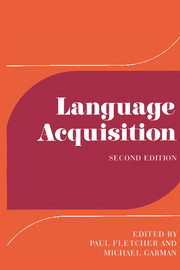Book contents
- Frontmatter
- Contents
- Contributors
- Preface
- Part I Contexts and determinants
- Part II The development of linguistic systems: phonology
- Introduction
- 7 Prespeech segmental feature development
- 8 Prosodic development
- 9 Early strategies for the perception and production of words and sounds
- 10 Phonological development: production
- 11 Speech perception and the emergent lexicon: an ethological approach
- 12 Phonological development: a crosslinguistic perspective
- Part III The development of linguistic systems: grammar
- Part IV Later language development
- Notes to chapters
- Bibliography and citation index
- General index
- Titles in the series
11 - Speech perception and the emergent lexicon: an ethological approach
Published online by Cambridge University Press: 05 June 2012
- Frontmatter
- Contents
- Contributors
- Preface
- Part I Contexts and determinants
- Part II The development of linguistic systems: phonology
- Introduction
- 7 Prespeech segmental feature development
- 8 Prosodic development
- 9 Early strategies for the perception and production of words and sounds
- 10 Phonological development: production
- 11 Speech perception and the emergent lexicon: an ethological approach
- 12 Phonological development: a crosslinguistic perspective
- Part III The development of linguistic systems: grammar
- Part IV Later language development
- Notes to chapters
- Bibliography and citation index
- General index
- Titles in the series
Summary
Introduction
If the phonology of an established language includes a set of rules which relate internal representations to surface forms, to understand a developing phonology one must infer the child's stored lexical forms from observations of his physical expression of those forms. Child phonologists would then seek to determine the relationship between stored and articulated forms, hence, the nucleus of the child's phonology. Those wishing to understand deviant utterances would additionally look for discrepancies between the child's internal representations and the prevailing forms in his environment.
As all phonologists need to know something of children's internal representations, it is embarrassing that most of us know nothing substantive about them. Even those who have diligently studied children's perception of speech know little of their internal representations of words. In the face of this, are phonologists hesitant to make statements about children's rule systems? Are developmental phonologists busily applying the techniques of cognitive psychology to reconstruct children's stored lexical forms? These would seem to be appropriate behaviours under the circumstances, but in fact many phonologists have suggested – and still appear to assume – that children ‘have the adult form as their internal representation’.
Peters (1974) has asked what it means to say ‘the adult form’ when there are lots of surface forms for any given word, within and across adult speakers.
- Type
- Chapter
- Information
- Language AcquisitionStudies in First Language Development, pp. 240 - 250Publisher: Cambridge University PressPrint publication year: 1986
- 11
- Cited by



